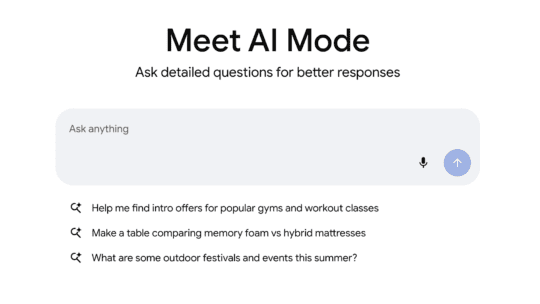
This week at Google I/O, the annual Google developers’ conference, the tech giant made a bold statement: AI is no longer an experiment in search—it IS search.
Google leadership unveiled the general rollout of AI Mode, a chatbot-style interface now embedded into Google’s apps. AI Mode seeks to compete with ChatGPT search, and can handle complex, multi-part questions and provide answers through Google’s vast web index, location data and even live feeds like weather or stock prices.
According to Fast Company, the rollout will begin this summer, and AI Mode will also gain agent capabilities, including search and tasks for booking reservations or buying concert tickets.
As Google’s Head of Search Liz Reid explained, this isn’t a side project—it’s a preview of Google search’s future.
How Brands Will Need to Pivot
This is big news for brands that depend on search traffic, as AI results pick only a few sites to reference when providing answers. Those answers show up at the top of search results, leaving web pages below—and leaving them behind. Codeword's VP and Head of Strategy, Jordan Leschinsky, has been counseling clients on the value of SEO in the age of AI search. She’s advising how to win with the “AI Visibility Triangle: Content, Comms, and Community.”
“People spent years just saying "Google it" to mean search it,” Leschinsky says. “With the AI mode just announced at I/O, "Google it" means... so much more. It can mean find it, source it, research it, answer it, create it, do it, brainstorm it, track it and more.”
She says search is no longer just an index for a brand's web pages, it’s a brand awareness and engagement platform.
“In a world where Google Search has thrown out the rule book, [traditional] SEO rules no longer apply,” she states. “Marketers need to stop optimizing for search, and start optimizing for audiences if they want to avoid being left in the dark (p)ages.”
What Communicators Can Do Next
So how can communicators help and optimize content for these audiences? Leschinsky notes that the change to search must also be seen as a change in focus from performance marketing to brand building—meaning, putting your audience first.
“It's not a new concept, but it's one [that has been] historically deprioritized in the chase for KPIs over real business impact,” she says. “Many communicators are guilty of creating content for search first. The introduction of AI mode and many users turning to AI tools over traditional search means that communicators can no longer ask "What will please the algorithm and ensure my content appears ahead of the competition?" They will now need to ask "What are audiences after and how can I best serve that?" because that is what AI mode and other AI search tools are trying to deliver.”
In regards to that “AI Visibility Triangle?” It means communicators need to take a holistic approach to tackling content, communications and communities in order to earn AI’s endorsement.
“Building authority in the eyes of AI requires going beyond your brand's owned content to ensure you're embracing proactive, brand-first PR and building active communities.”
Nicole Schuman is Managing Editor of PRNEWS.
